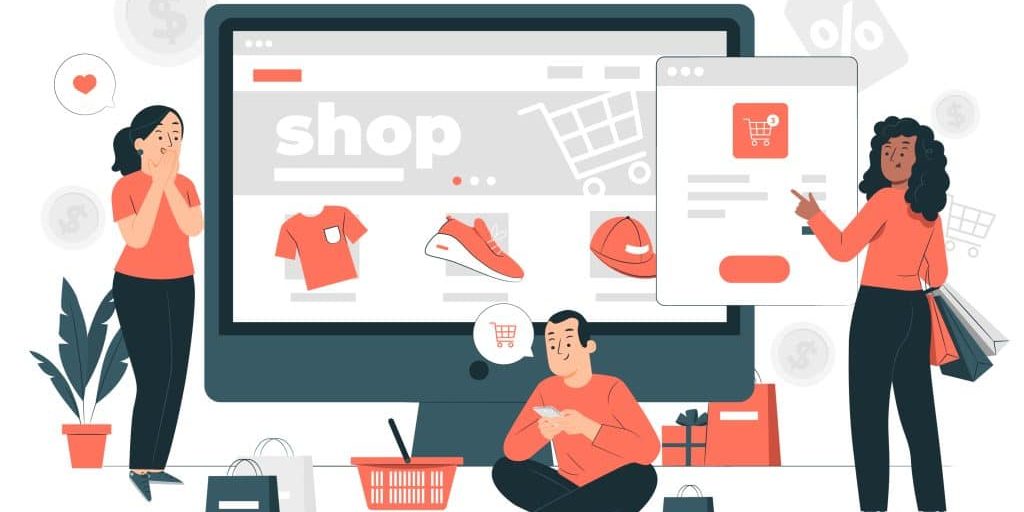 In today’s competitive digital marketplace, having a retail website is essential for reaching customers and driving sales. However, simply having an online presence is not enough. To succeed, retail websites must be optimized for performance, user experience, and conversion rates. Explore the most common methods to improve e-commerce retail websites. Learn how to improve retail websites for better results. For more help, work with retail industry experts. Why guess? Use only proven strategies when working with industry leading experts.
In today’s competitive digital marketplace, having a retail website is essential for reaching customers and driving sales. However, simply having an online presence is not enough. To succeed, retail websites must be optimized for performance, user experience, and conversion rates. Explore the most common methods to improve e-commerce retail websites. Learn how to improve retail websites for better results. For more help, work with retail industry experts. Why guess? Use only proven strategies when working with industry leading experts.
Enhance User Experience (UX)
Simplify Navigation
A well-organized and intuitive navigation system is crucial for helping visitors find what they’re looking for quickly. A confusing or cluttered menu can frustrate users, leading to higher bounce rates.
Facts:
- 38% of users will stop engaging with a website if the content or layout is unattractive (Source: Adobe).
- Websites with clear navigation can increase user satisfaction and lead to a 200% improvement in conversion rates (Source: Forrester).
Methods:
- Organize Categories: Group products into clear categories and subcategories, using descriptive labels.
- Implement a Search Bar: Add a prominent search bar with autocomplete and filtering options to help users quickly find specific products.
- Use Breadcrumbs: Include breadcrumb navigation to help users understand their location on the site and easily backtrack.
Optimize for Mobile
With more than half of all web traffic coming from mobile devices, optimizing your retail website for mobile users is essential. A mobile-friendly site ensures that customers have a seamless experience across all devices.
Facts:
- Mobile e-commerce sales are expected to account for 72.9% of total e-commerce sales by 2021 (Source: Statista).
- 61% of users are unlikely to return to a mobile site they had trouble accessing, and 40% visit a competitor’s site instead (Source: Google).
Methods:
- Responsive Design: Implement responsive design to ensure your website adjusts smoothly to different screen sizes.
- Optimize Images and Media: Compress images and videos to reduce load times on mobile devices without sacrificing quality.
- Streamline Navigation: Simplify menus and navigation for mobile users, ensuring that touch elements are easy to interact with.
Improve Page Load Speed
Slow-loading pages can drastically affect user experience and conversion rates. A faster website not only keeps users engaged but also ranks better in search engines.
Facts:
- A one-second delay in page load time can lead to a 7% reduction in conversions (Source: Akamai).
- 53% of mobile users will abandon a site that takes longer than three seconds to load (Source: Google).
Methods:
- Use a Content Delivery Network (CDN): CDNs store copies of your website on servers around the world, reducing load times for users by serving content from a server close to them.
- Optimize Code: Minimize, compress, and defer unnecessary JavaScript and CSS to reduce load times.
- Enable Browser Caching: Store static files in the user’s browser to speed up repeat visits.
Improve Product Pages
Use High-Quality Images and Videos
High-resolution images and videos provide a better understanding of the product, leading to higher engagement and conversion rates. Customers want to see every detail of the product before making a purchase decision.
Facts:
- Product videos can increase purchases by 144% (Source: Neil Patel).
- 93% of consumers consider visual appearance to be the key deciding factor in a purchasing decision (Source: Justuno).
Methods:
- Multiple Angles: Provide images from multiple angles to give users a complete view of the product.
- Zoom Functionality: Allow users to zoom in on images to examine details closely.
- Product Videos: Include videos that demonstrate the product in use or highlight its features.
Write Detailed and Persuasive Descriptions
Product descriptions should not only be informative but also persuasive. They should clearly explain the product’s benefits, features, and specifications. Learn how to improve retail websites for better results. For more help, work with retail industry experts.
Facts:
- 87% of consumers say that detailed product content is important when deciding to buy (Source: Salsify).
- Well-written descriptions can reduce return rates, as customers have a clearer understanding of the product before purchasing.
Methods:
- Highlight Key Features: Use bullet points to outline the most important features and benefits.
- Use Descriptive Language: Engage customers with vivid, descriptive language that paints a picture of how the product can improve their lives.
- Include Technical Details: Provide specifications, such as size, materials, and ingredients, to cater to both general and technical shoppers.
Add Customer Reviews and Ratings
Customer reviews and ratings build trust and credibility, making new visitors more likely to make a purchase. Reviews provide social proof, showing potential buyers that others have had positive experiences with your products.
Facts:
- 95% of shoppers read online reviews before making a purchase (Source: Spiegel Research Center).
- Products with five reviews are 270% more likely to be purchased than products with no reviews (Source: Spiegel Research Center).
Methods:
- Encourage Reviews: Prompt customers to leave reviews after a purchase by sending follow-up emails or offering incentives.
- Display Ratings: Make star ratings visible on product pages to provide a quick overview of customer satisfaction.
- Respond to Reviews: Engage with customers by responding to reviews, addressing concerns, and thanking them for their feedback.
Optimize for Search Engines (SEO)
Perform Keyword Research
Keyword research is essential for understanding what potential customers are searching for and how to tailor your content to meet their needs. By optimizing your website for relevant keywords, you can attract more organic traffic.
Facts:
- SEO drives 1000%+ more traffic than organic social media (Source: BrightEdge).
- 68% of online experiences begin with a search engine (Source: BrightEdge).
Methods:
- Use SEO Tools: Tools like Google Keyword Planner, Ahrefs, and SEMrush can help you identify high-volume, low-competition keywords relevant to your products.
- Optimize Meta Tags: Include targeted keywords in your title tags, meta descriptions, and header tags to improve search engine rankings.
- Create SEO-Friendly URLs: Use short, descriptive URLs that include primary keywords.
Optimize Content for Search Engines
In addition to keyword optimization, your website’s content should be structured and written in a way that is both user-friendly and search engine-friendly. Learn how to improve retail websites for better results. For more help, work with retail industry experts.
Methods:
- Use Header Tags: Break up content with header tags (H1, H2, H3) to make it easier for search engines to understand the structure of your content.
- Create High-Quality Content: Regularly update your website with informative blog posts, guides, and product pages that offer value to users and improve SEO.
- Optimize Alt Text: Add descriptive alt text to images, including relevant keywords, to improve visibility in image search results.
Build High-Quality Backlinks
Backlinks from reputable websites signal to search engines that your website is a trusted source of information, which can improve your rankings.
Facts:
- Backlinks remain a significant ranking factor in Google’s algorithm (Source: Backlinko).
- Websites with a strong backlink profile are more likely to rank higher in search results (Source: Moz).
Methods:
- Guest Blogging: Write guest posts for industry-related blogs and include links back to your website.
- Influencer Outreach: Partner with influencers and bloggers who can link to your products in their content.
- Content Marketing: Create shareable content, such as infographics or research reports, that other sites will want to link to.
Streamline the Checkout Process
Simplify Checkout Steps
A complicated or lengthy checkout process is one of the main reasons for cart abandonment. Streamlining the process can significantly increase conversion rates.
Facts:
- 21% of US online shoppers abandon their cart due to a long and complicated checkout process (Source: Baymard Institute).
- A one-page checkout can increase conversion rates by up to 21.8% (Source: WooCommerce).
Methods:
- Guest Checkout: Allow users to make purchases without creating an account.
- Progress Indicators: Use progress indicators to show customers how many steps are left in the checkout process.
- Auto-Fill Forms: Implement auto-fill features to save customers time and reduce friction.
Offer Multiple Payment Options
Providing a variety of payment options caters to different customer preferences and can reduce cart abandonment rates.
Facts:
- 8% of US online shoppers abandon their cart due to a lack of payment options (Source: Baymard Institute).
- Offering digital wallet options like PayPal can increase conversions by 5% (Source: Invesp).
Methods:
- Credit and Debit Cards: Accept major credit and debit cards, such as Visa, Mastercard, and American Express.
- Digital Wallets: Include payment options like PayPal, Apple Pay, and Google Pay to cater to tech-savvy customers.
- Buy Now, Pay Later: Offer installment payment options through services like Klarna or Afterpay.
Display Trust Signals
Trust is crucial in e-commerce. Displaying trust signals can reassure customers that their payment information is secure, reducing cart abandonment.
Facts:
- 17% of US online shoppers abandon their cart because they didn’t trust the website with their credit card information (Source: Baymard Institute).
- Websites with trust badges can increase conversion rates by up to 42% (Source: ConversionXL).
Methods:
- SSL Certificates: Ensure your website is secure with an SSL certificate, indicated by “https://” in the URL.
- Trust Badges: Display security badges, such as Norton Secured, McAfee Secure, or Trustpilot, to reassure customers.
- Transparent Policies: Clearly communicate your return, refund, and privacy policies to build trust.
Conclusion
Improving a retail e-commerce website involves focusing on key areas such as user experience, product pages, SEO, and the checkout process. By enhancing these elements, businesses can attract more traffic, improve customer satisfaction, and increase conversion rates. The statistics show that even small improvements in these areas can lead to significant gains in sales and customer loyalty. Investing in these strategies is essential for staying competitive in the rapidly evolving e-commerce landscape and ensuring long-term success. Learn how to improve retail websites for better results. For more help, work with retail industry experts. Why guess? Use only proven strategies when working with industry leading experts.








